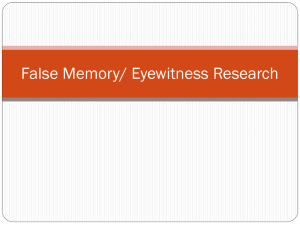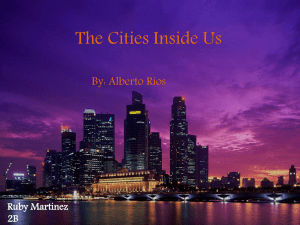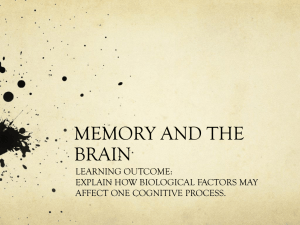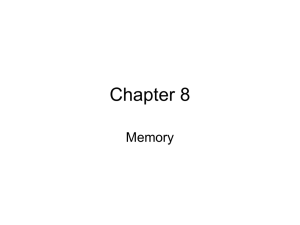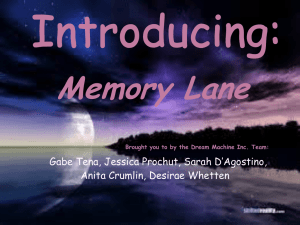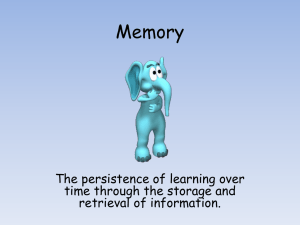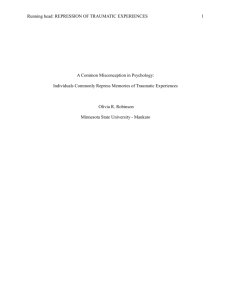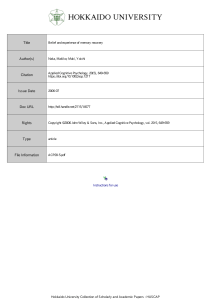36x48 Tri-Fold Template - UCI Webfiles
advertisement
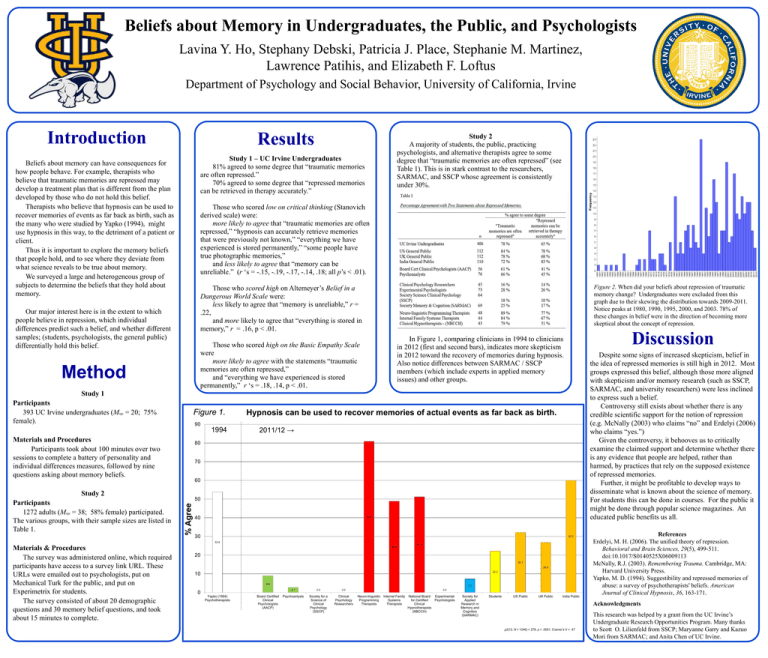
Beliefs about Memory in Undergraduates, the Public, and Psychologists Lavina Y. Ho, Stephany Debski, Patricia J. Place, Stephanie M. Martinez, Lawrence Patihis, and Elizabeth F. Loftus Department of Psychology and Social Behavior, University of California, Irvine Introduction Results Study 2 A majority of students, the public, practicing psychologists, and alternative therapists agree to some degree that “traumatic memories are often repressed” (see Table 1). This is in stark contrast to the researchers, SARMAC, and SSCP whose agreement is consistently under 30%. Study 1 – UC Irvine Undergraduates 81% agreed to some degree that “traumatic memories are often repressed.” 70% agreed to some degree that “repressed memories can be retrieved in therapy accurately.” Beliefs about memory can have consequences for how people behave. For example, therapists who believe that traumatic memories are repressed may develop a treatment plan that is different from the plan developed by those who do not hold this belief. Therapists who believe that hypnosis can be used to recover memories of events as far back as birth, such as the many who were studied by Yapko (1994), might use hypnosis in this way, to the detriment of a patient or client. Thus it is important to explore the memory beliefs that people hold, and to see where they deviate from what science reveals to be true about memory. We surveyed a large and heterogeneous group of subjects to determine the beliefs that they hold about memory. Those who scored low on critical thinking (Stanovich derived scale) were: more likely to agree that “traumatic memories are often repressed,” “hypnosis can accurately retrieve memories that were previously not known,” “everything we have experienced is stored permanently,” “some people have true photographic memories,” and less likely to agree that “memory can be unreliable.” (r ‘s = -.15, -.19, -.17, -.14, .18; all p’s < .01). Those who scored high on Altemeyer’s Belief in a Dangerous World Scale were: less likely to agree that “memory is unreliable,” r = .22, and more likely to agree that “everything is stored in memory,” r = .16, p < .01. Our major interest here is in the extent to which people believe in repression, which individual differences predict such a belief, and whether different samples; (students, psychologists, the general public) differentially hold this belief. Figure 2. When did your beliefs about repression of traumatic memory change? Undergraduates were excluded from this graph due to their skewing the distribution towards 2009-2011. Notice peaks at 1980, 1990, 1995, 2000, and 2003. 78% of these changes in belief were in the direction of becoming more skeptical about the concept of repression. Those who scored high on the Basic Empathy Scale were more likely to agree with the statements “traumatic memories are often repressed,” and “everything we have experienced is stored permanently,” r ‘s = .18, .14, p < .01. Method Discussion In Figure 1, comparing clinicians in 1994 to clinicians in 2012 (first and second bars), indicates more skepticism in 2012 toward the recovery of memories during hypnosis. Also notice differences between SARMAC / SSCP members (which include experts in applied memory issues) and other groups. Despite some signs of increased skepticism, belief in the idea of repressed memories is still high in 2012. Most groups expressed this belief, although those more aligned with skepticism and/or memory research (such as SSCP, SARMAC, and university researchers) were less inclined to express such a belief. Controversy still exists about whether there is any credible scientific support for the notion of repression (e.g. McNally (2003) who claims “no” and Erdelyi (2006) who claims “yes.”) Given the controversy, it behooves us to critically examine the claimed support and determine whether there is any evidence that people are helped, rather than harmed, by practices that rely on the supposed existence of repressed memories. Further, it might be profitable to develop ways to disseminate what is known about the science of memory. For students this can be done in courses. For the public it might be done through popular science magazines. An educated public benefits us all. Study 1 Participants 393 UC Irvine undergraduates (Mage = 20; 75% female). Figure 1. 90 Materials and Procedures Participants took about 100 minutes over two sessions to complete a battery of personality and individual differences measures, followed by nine questions asking about memory beliefs. 2011/12 → 80 70 60 Study 2 50 % Agree Participants 1272 adults (Mage = 38; 58% female) participated. The various groups, with their sample sizes are listed in Table 1. 1994 Hypnosis can be used to recover memories of actual events as far back as birth. 40 80.9 30 60.0 53.8 Materials & Procedures The survey was administered online, which required participants have access to a survey link URL. These URLs were emailed out to psychologists, put on Mechanical Turk for the public, and put on Experimetrix for students. The survey consisted of about 20 demographic questions and 30 memory belief questions, and took about 15 minutes to complete. 48.8 51.2 20 32.1 26.8 22.2 10 8.9 0 Yapko (1994) Psychotherapists Board Certified Clinical Psychologists (AACP) 7.2 2.7 0.0 0.0 Psychoanlysts Society for a Science of Clinical Psychology (SSCP) Clinical Psychology Researchers 0.0 Neuro-linguistic Internal Family Programming Systems Therapists Therapists National Board Experimental for Certified Psychologists Clinical Hypnotherapists (NBCCH) Society for Applied Research in Memory and Cognition (SARMAC) Students US Public UK Public India Public References Erdelyi, M. H. (2006). The unified theory of repression. Behavioral and Brain Sciences, 29(5), 499-511. doi:10.1017/S0140525X06009113 McNally, R.J. (2003). Remembering Trauma. Cambridge, MA: Harvard University Press. Yapko, M. D. (1994). Suggestibility and repressed memories of abuse: a survey of psychotherapists' beliefs. American Journal of Clinical Hypnosis, 36, 163-171. Acknowledgments χ2(12, N = 1246) = 278, p < .0001, Cramer’s V = .47 This research was helped by a grant from the UC Irvine’s Undergraduate Research Opportunities Program. Many thanks to Scott O. Lilienfeld from SSCP; Maryanne Garry and Kazuo Mori from SARMAC; and Anita Chen of UC Irvine. www.postersession.com
